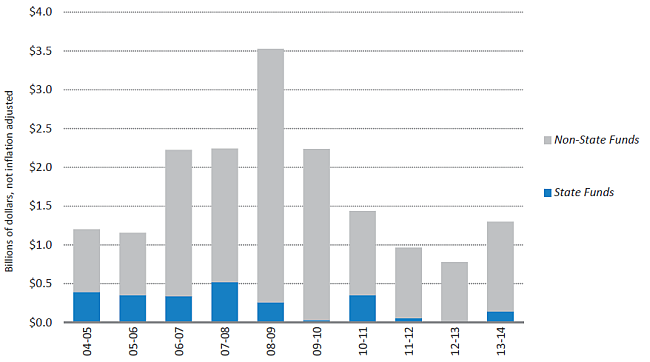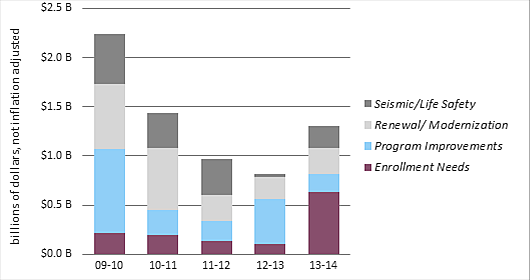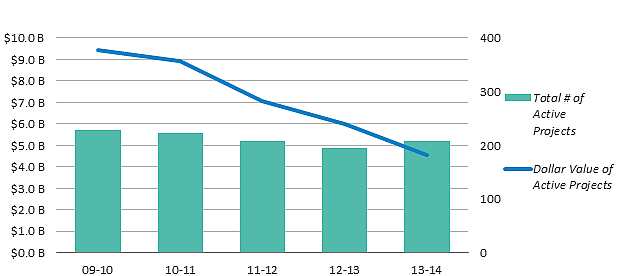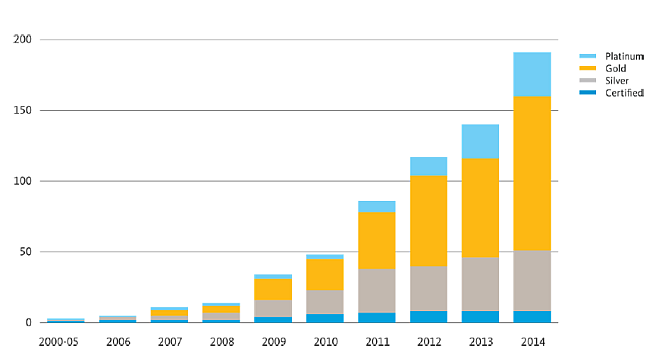Chapter 13:
Capital Program and Sustainability
UC’s capital program
The University maintains more than 5,800 buildings enclosing 130 million square feet on approximately 30,000 acres across its ten campuses, five medical centers, nine agricultural research and extension centers, and the Lawrence Berkeley National Laboratory. With such a substantial infrastructure, the University strives to be a good steward of the capital resources entrusted to its care.
Sources of capital funding
Historically, the majority of UC’s core academic infrastructure projects were funded by the state. However, over the past decade, the state’s contribution has fallen to about 15 percent, and external financing now plays the dominant role. Approximately half of UC’s existing space is eligible for maintenance using state funds; the other half is occupied by self-supporting enterprises, such as parking and housing. Since the mid-1980s, state funding for capital renewal and deferred maintenance has been minimal and unpredictable, significantly affecting the University’s limited resources and its ability to maintain its facilities.
Capital expenditures
During FY 2013–14, UC spent about $1.3 billion on capital projects, with nearly two-thirds of this amount funded from external financing. The majority of these projects, as well as those going back to at least 2009–10, were for projects aimed at core academic programs and aging facilities.
An expanding infrastructure
Since 2003, the space available to UC for program uses has increased by 15.7 million square feet. Even more space must be added to accommodate enrollment growth and expanding programs. In addition, UC must maintain and upgrade its facilities, more than half of which are at least 35 years old. Capital requirements for just the next five years are estimated at $6.7 billion, the great majority of which will be met through external financing.
UC’s sustainability program
The University of California is a national leader in sustainability. The University affirmed its leadership position in 2007 when all ten chancellors signed the American College & University Presidents’ Climate Commitment. Furthering this leadership, in November 2013, UC announced an initiative to achieve carbon neutrality by 2025. This initiative will make UC the first major research university to achieve carbon neutrality.
The initiative builds on UC’s work on climate and carbon neutrality research (as detailed in Chapter 9) and furthers its leadership in sustainable business practices. UC is improving its energy efficiency, developing new sources of renewable energy and enacting a range of related strategies to cut carbon emissions.
The University’s Policy on Sustainable Practices, updated in 2013, has multiple areas of focus: Climate Action, Green Building, Clean Energy, Transportation, Recycling and Waste Management, Environmentally Preferable Procurement and Sustainable Food Services. These efforts demonstrate the University’s commitment to wise stewardship of its resources and the environment. UC continues to lead higher education in sustainability as demonstrated in the 2014 annual report on sustainable practices: http://ucop.edu/sustainability/_files/annual-sustainability-report2014.pdf
Successes noted in this year’s report include $138M in cumulative avoided energy costs via Energy Efficiency Partnership projects; 23 megawatts of on-site renewable electrical generation (installed or under contract); and 191 LEED certifications, the most of any higher education institution in the country.
The University has formed an Energy Services Unit (ESU) to implement large systemwide renewable energy strategies using the University’s capability to finance projects at favorable rates. The ESU is pursuing four strategies to achieve carbon neutrality:
- Expand the highly successful statewide Energy Efficiency Partnership program.
- Develop a wholesale power procurement strategy that provides a steadily increasing amount of renewable power.
- Procure large quantities of biomethane (biogas) in lieu of natural gas.
- Proactively manage UC’s carbon allowances and offsets in compliance with California’s cap-and-trade program.
FOR MORE INFORMATION
The major portion of UC’s capital project funding over the last ten years derives from nonstate fund sources.
13.1.1 Sources of capital spending, Universitywide, based on budgets approved each year, 2004–05 to 2013–14

Source: UC Capital Programs
UC’s capital program is funded by a combination of state and nonstate funds. State funds were historically the primary source of funding for core academic facilities. Nonstate sources fund self-supporting enterprises, such as housing, parking, athletics and medical enterprises, which are generally not eligible for state funding.
State funding for the University’s capital improvement projects has been unpredictable over the last five years as a result of the economic downturn and the state’s objective to reduce its overall bond debt. The University had anticipated approval of general obligation bond measures in the past few voting cycles, yet these measures were never placed on the ballot. The last general obligation bond measure passed in November 2006. Over the past decade, nonstate funds, which include gifts, grants, bonds and other sources, have accounted for almost 85 percent of UC’s capital program funding.
Nonstate funding represents a diverse set of fund sources to support the capital projects. The use of long-term debt has played an increasingly pivotal role in supporting the University’s capital program.
Nearly two-thirds of the cost of capital projects during 2013–14 was met through external financing.
13.1.2 Sources of capital spending detail, Universitywide, 2013–14

Source: UC Capital Programs
With state funds playing a declining role in UC’s capital program, reliance on external financing has increased, and a new debt service model has emerged in response. The 2013–14 state legislative session saw a major change in how UC manages its debt service on capital outlay, which has a significant impact on capital programs. Assembly Bill No. 94 shifted this debt service from the state to the University. This allowed the University to refinance under more favorable terms than were available to the state.
More broadly, this legislation provided unprecedented and exceptional fiscal flexibility to the University of California. The University is now able, under certain conditions, to use its State General Fund allocation to finance a variety of capital needs: designing, constructing and equipping of academic facilities; addressing seismic and life safety needs; accommodating enrollment growth; modernizing out-of-date facilities; and expanding infrastructure to serve academic programs.
Nearly two-thirds of the cost of capital projects during 2013–14 was met through external financing.
13.1.3 Types of capital projects, Universitywide, 2009–10 to 2013–14

Source: UC Capital Programs
Continuing enrollment growth has largely driven the University’s requirement for new laboratories, classrooms, student housing and recreational facilities.
Academic, research and clinical priorities change over time. New program initiatives require specialized space, involving renovation of existing infrastructure or construction of new facilities.
From 2009–10 to 2013–14, the University devoted $1.5 billion to seismic and life-safety corrections to buildings. The University continues to review the seismic safety of its facilities, prioritize buildings for remediation and implement seismic upgrades.
Additionally, as campus facilities age, they must be renewed and modernized to ensure safety, extend the useful life of the buildings and improve energy efficiency. Heating, ventilation, electrical and plumbing systems, elevators, and roofs need periodic replacement and renewal during the lifespan of a building. Due principally to declining state support, the University has a substantial backlog of deferred maintenance.
The University’s capital portfolio has declined slightly, reflecting the economic downturn in California.
13.1.4 Active projects, Universitywide, 2009–10 to 2013–14

Source: UC Capital Programs
Active projects are those with approved budgets that are under design or construction at the end of each fiscal year. Because capital projects typically take from three to five years to design and construct, the data for any single year present a snapshot of a cumulative process going on over several years.
The University continues to develop and implement efficiency strategies for facility design and construction. New models for planning office space, such as the Faculty Office Building at UCSF’s Mission Bay, reorganize floor plans to reflect modern work patterns of group collaboration by eliminating many private offices, clustering open workspaces and providing ample shared meeting spaces in a variety of sizes.
The University has expanded its use of construction contracting, enabling campuses to match the needs of different types of projects with the most efficient construction delivery for that project, considering cost efficiency, speed of delivery, local business climate and other factors that vary by location, current market conditions and project type.
Most of the growth in space over the last ten years has been for instruction and research, offices and residential uses.
13.1.5 Assignable Square Footage (ASF), Universitywide, 2003 to 2013

Source: UC Capital Programs
Assignable square footage (ASF) is the space available for program uses. It does not include corridors, bathrooms or building infrastructure. Systemwide, space has increased by 15.7 million ASF since 2003, driven by several related growth factors.
Increases in the student population have required significant additions to athletic, recreational and food service space. Residential space has grown as campuses strive for more on-campus student housing to reduce environmental impacts from commuting, to improve air quality and to improve student life in living/learning communities. This is especially important for first-year students, many of whom are the first in their families to attend college.
Instructional, research and office space has also increased over the last ten years. In addition, UC Merced, the newest UC campus, continues to grow, and other campuses have experienced growth in specific disciplines or programs.
The University will need $6.7 billion over the next five years to address its most critical facility needs.
13.1.6 Infrastructure needs, Universitywide, 2013–14 to 2017–18
University of California Infrastructure Report: 2014–15 to 2018–19 (millions)
| Capital Infrastructure Needs |
14–15 |
15–16 |
16–17 |
17–18 |
18–19 |
Total |
| Infrastructure Deficiencies |
$433 |
$443 |
$448 |
$373 |
$465 |
$2,162 |
| Renewal/Modernization |
$579 |
$538 |
$543 |
$393 |
$665 |
$2,718 |
| Enrollment/Program |
$125 |
$213 |
$1,004 |
$110 |
$340 |
$1,792 |
| Total |
$1,137 |
$1,194 |
$1,995 |
$876 |
$1,470 |
$6,672 |
Source: UC Capital Programs
The University’s Statewide Infrastructure Report: 2014–15 Through 2018–19 estimates that UC will need approximately $1.33 billion in capital funding on average each year over the next five years to address its most pressing facilities needs for academic-related space. Three major factors determine these needs:
- Critical infrastructure deficiencies. UC’s planned program of seismic corrections is one of the University’s highest priorities. With an estimated cost of approximately $2 billion, the program will be implemented over the next 10 to 15 years, depending on availability of funding. The University also has fire and other life-safety upgrades planned to meet updated code requirements.
- Systematic renewal and modernization of existing space to address obsolescence. Even with recent investments in new facilities, more than half of the University’s state-supportable facilities are 35-plus years old and require renewal and modernization. The need for funding to support systematic renewal and replacement of building systems has significantly outpaced available funds. In addition, facility improvements are needed to accommodate changing programmatic requirements.
- Enrollment and programmatic growth. The University enrolls more students than were provided for by state funds, and as a result, UC is currently overenrolled. The system continues to experience extremely high demand from qualified students.
UC has made consistent progress toward its greenhouse gas emission goals.
13.2.1 Greenhouse gas emissions, Universitywide compared to Climate Goals, 2009 to 2013

Source: UCOP energy and Sustainability Office1
The University’s greenhouse gas (GHG) emissions totaled 1.6 million metric tons carbon dioxide equivalent (CO2e) in 2013. Forty-seven percent of the total emissions come from Scope 1 sources — natural gas, campus fleet and fugitive emissions (such as refrigerants or certain gases used in research). Twenty-six percent come from Scope 2 sources — purchased electricity and steam. The final 26 percent comes from Scope 3 emissions — campus commute and business air travel. Despite continued growth in building space, total emissions have been declining over the past two years. UC’s total emissions are on track to fall below 2000 levels when 2014 emissions are reported and verified in fall 2015.
In 2013, Davis, Riverside, San Francisco, Santa Barbara and Santa Cruz emitted fewer metric tons of GHGs than in 2000; these campuses are also expected to meet the policy goal when 2014 emissions are reported and verified in 2015. Berkeley has already achieved emissions below 1990 levels, surpassing the 2020 policy goal seven years early. UCLA expects to meet the 2020 policy goal for its 2014 emissions inventory as well, when emissions are verified in fall 2015. All campuses have a climate action plan identifying measures to reduce GHG emissions. Campuses are currently in the process of updating these plans to include the 2025 carbon neutrality goal.
1 Emissions in the graph above account for Scope 1 and Scope 2 emissions, consistent with the Carbon Neutrality Initiative. Scope 1 encompasses emissions that result directly from campus activities, primarily fossil fuel combustion. Scope 2 covers emissions associated with electricity and steam generated by a third party and sold to a campus.
Energy efficiency upgrades will result in cumulative net avoided costs for the University of $170 million by the end of 2015.
13.2.2 Energy efficiency cost avoidance, Universitywide, 2005 to 2015

Source: UCOP energy and Sustainability Office. Dollars are net of debt services and not inflation-adjusted.
Ten years ago, the University formed a unique Statewide Energy Partnership program with the California State University system and the state’s four investor-owned utilities to improve the energy performance of existing buildings. The energy efficiency projects implemented through the Partnership have been the main strategy utilized by campuses to meet the 2014 policy goal for greenhouse gas emissions reductions.
In 2014, the University received approximately $7.1 million in incentives from the Partnership to implement 80 projects. Those projects are projected to save approximately 27 million kilowatt-hours (kwh) of electricity and 1.3 million therms of natural gas annually.
Energy efficiency projects since the program began in 2004 allow UC to avoid over $28 million in additional energy costs annually; UC’s annual energy costs would be 10 percent higher if these projects had not been implemented. This program’s cumulative avoided costs reached $138 million by the end of 2014.
Projects completed in 2014 will increase these cumulative savings to approximately $170 million by the end of 2015. While campuses have used a portfolio approach to balance projects with shorter and longer paybacks, they have now implemented most of the “low-hanging fruit.”
The future focus on deeper energy efficiency retrofits to achieve climate goals will likely result in lower levels of net avoided costs because of larger up-front investments.
By the end of 2014, UC had achieved 191 LEED® certifications, more than any other university in the country.
13.2.3 LEED® certifications, Universitywide, 2000 to 2014 (cumulative)

Source: UC Capital Resources Management
Leadership in Energy & Environmental Design (LEED)® standards, developed by the nonprofit U.S. Green Building Council, has emerged as an internationally recognized benchmark for sustainable design. UC’s sustainability policy requires all new construction projects and renovation projects over $5 million to achieve a minimum of LEED® Silver certification.
By the end of 2014, the University of California had 191 LEED® certified projects (new construction, renovation, homes and existing building certifications), the most of any university in the country. Fifty-one of these projects were certified in 2014, with seven earning Platinum certification, 39 earning Gold, and five earning Silver.
UC LEED® certifications are listed here.
Beyond sustainability in new construction, UC has also adopted LEED® for Existing Buildings, Operations and Maintenance (LEED®-EBOM), to “green” the day-to-day, ongoing environmental performance of its existing facilities. UC buildings have received 22 LEED®-EBOM certifications, and 16 additional projects are in progress or in planning. Santa Barbara leads the nation with 10 certifications, more than any other university.







